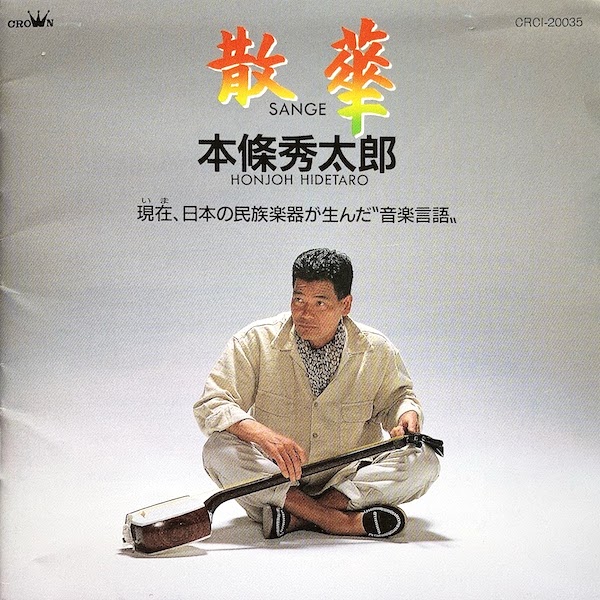
Trying to find a nexus point for anything can seem like a fool’s errand at times. Usually, the lines of history get blurry and the waters of memory get murkier. However, in the case of Hidetaro Honjoh’s 散華 (Sange), there are two planes that meet. Here his roots in traditional folk music clearly spring something far more contemporary. Inspired by the possibilities of “modernity”, Hidetari mutates his unimpeachable shamisen technique into the riskier, new, Japanese world music that was like precious else. Here, we can retrace his pioneering footsteps.
To understand Hidetaro one has to understand his journey to the instrument of his choosing: the shamisen. Strung in three courses, it resembles in tone a love child of the American banjo and dulcimer. However, it was this instrument (one used to accompany Japanese theater and court music) that his family saw as his gateway out of the red-light town of Itako-City in Allied-occupied Japan.

From a young age Hidetaro would pass through the rigorous route a masterful shamisen player would take to be part of that lineage. He could have followed the path of others like Tadao Sawai and Hōzan Yamamoto (both masters of their respective instruments) who retreated from their more digestible experiments back into the tradition but he took a path untravelled.
By the early ‘70s he’d honed his skill so far as to create his own method, he’d dub “Honjoh” style. It’s this style that would start to present frail strands in the suture of folk music he’d been studying and weaving together. His own technique had grown decidedly more fiery. It had grown far more muscular and experimental, perhaps more than the folk music he studied allowed for. And on record, Hidetaro started to create a new form of traditional music he’d call “Risogaku” combining performance art with freer, rural, Minyo folk fused with the more conservative, Hauta traditional music.
By the ‘80s Hidetaro realized how much more this direction could offer by simply embracing the more improvisatory side of his ideas. Building off his own teaching method, he’d try to afford his time to artists both inside and outside of the new, Japanese folk school, doing so to promote a new way forward for younger students hungry to move the instrument forward.

Whether working with artists as disparate as Naomi Tani to Imitation, Hidetaro afforded himself the flexibility to show that this instrument belonged in the future of Japanese music. Likewise, as he sought new avenues — like film, TV, and commercial work — to sketch out his ideas on modern folk music, so too were new opportunities opened for him.
It was sometime in 1989 when he received a call from one Haruomi Hosono. You see it was in the mid ‘70s when Mr. Hosono had become disenchanted with much of the “western-influenced” pop world and became illusioned by the music of Okinawa and of world music in general. One of the artists that had drawn his attention then was Hidetaro himself whose new folk music he heard on albums like 琴と津軽三味線 みちのくひとり旅. Using his shamizen to play in a myriad of styles, Hidetaro was as untethered on tape as Harry wanted to be. Inspired by world music but also trying to move away from a distinct, placeable tradition, and instead into a more pliable purpose for it. In Hidetaro he saw someone simpatico in thought.
Hidetaro would be the one who’d ask Hosono to help direct a modern Minyo production he created titled: “ATAVUS”. Shortly thereafter while working on the record that would become Omni Sight Seeing he had to find a place for Hidetaro to contribute. As hinted on that release, two tracks — Esashi (a short, ethereal instrumental) and Pleocene (arguably, the album’s highlight) — showed that for as much as Mr. Hosono saw something in him, Hidetaro (importantly) felt something inspirational with equal reciprocation and used those two tracks to experiment with this third way music.
Just a year later Hidetaro would take this same spirit of experimentation into the studio to create his 散華 (Sange). Fusing folk with synthesizer, erhu with fue, koto with Buddhist chant, Hidetaro took all these scattered trails and pointed them into his shamisen.

The quiet sonority of “メイ(MAY…)” combusts as quickly as it begins, signaling a new voice ready to belt out. “巡礼 PART1(PILGRIMAGE)” fully realizes the intensity of the shamisen onto the other realms of both traditional and contemporary instruments. Human voices chant in only the ways such timeless communicative communion can. A mysterious brew boils over until the only mystery is how this atmosphere maintains both hands on all spheres. Omnidirectional, this is where 散華 (Sange) earns its creation story as new Japanese world music.
Somehow, on tracks like “阿修羅(ASHURA)” and “阿修羅(ASHURA)”, uncategorizable, technical, musical vocabulary forms its own idiom mouthing words only Hidetaro could conjure with his own bare hands.
